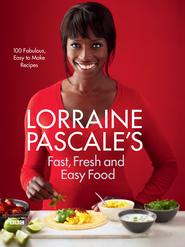По всем вопросам обращайтесь на: info@litportal.ru
(©) 2003-2024.
✖
Baking Made Easy
Настройки чтения
Размер шрифта
Высота строк
Поля
Preheat the oven to 200°C (400°F), Gas Mark 6. Line the sides of the cake tin with baking paper, so it sticks up a good 10cm (4in) above the top of the tin.
Put flour, salt, yeast, milk, eggs, yolks, vanilla, maple syrup, coffee and butter in a large bowl and stir well to combine. Keep mixing the dough for 10 minutes by hand (it is usually too sticky for the hand at first so use a wooden spoon and keep mixing), or for 5 minutes if using an electric mixer fitted with a dough hook. The dough will be very very sticky, almost like a cake batter. This is what gives the panettone its wonderful spongy texture.
Tip the dough into the prepared cake tin and lay a tea towel gently over the top. Leave in a warm place for about 1 hour, or until the mixture has almost risen to the top of the tin.
For the eggwash, mix the egg and milk together in a bowl. Once the dough has almost doubled in size, brush the top of the panettone with the eggwash, then make a cross in the top with a very sharp knife. Bake in the oven for 45–50 minutes, or until the bread is well risen, lifts out of the tin easily and a skewer inserted into the thickest part comes out clean.
Remove the panettone from the oven, drizzle with maple syrup and use a brush to spread it evenly over the bread. This gives the loaf a shiny top and adds extra maple flavour. Leave the panettone to cool in the tin.
Variation The coffee can be omitted and replaced with 400g (14oz) mixed dried fruit and peel soaked in orange juice or rum. This turns it into a more traditional panettone.
Focaccia Bread
Great for sharing, and made even better with the use of a really fine extra-virgin olive oil. I keep a good bottle of extra-virgin on the top shelf of a cupboard, away from prying hands who may want to use the oil for frying eggs or other unworthy cooking tasks. On special occasions, such as making focaccia, the imperial bottle of oil makes a rare appearance. Makes 1 large flat loaf
500g (1lb 2oz) strong white bread flour, plus extra for dusting
2 tsp salt
1 x 7g sachet of fast-action dried yeast
80ml (3fl oz) olive oil, plus extra for drizzling
150–250ml (5–9fl oz) warm water
Vegetable oil or oil spray, for oiling
1 bunch of fresh rosemary
Large pinch of sea salt
Dust a large flat baking tray with flour.
Put the flour in a large bowl, add the salt and yeast, then add the olive oil plus enough warm water to make a soft but not sticky dough. The dough should feel quite loose and not tight and difficult to knead. If the whole amount is added it may appear that the dough is beyond repair, but gently kneading by way of scooping up the dough, scraping any sticky bits on the surface and slapping it back down again for a few minutes will see the dough begin to become ‘pillowy’ and more manageable. The more water that can be added (the full 250ml/9fl oz is great) then the lighter the bread will be. But it can take some perseverance. Also resist the temptation to add more flour as it will make the dough too heavy.
Knead the dough for about 10 minutes by hand on a lightly floured work surface or for 5 minutes if using an electric mixer fitted with a dough hook. The dough will feel stretchy when pulled. To test if it is ready, make a ball with the dough then, using a well-floured finger, prod a shallow indent in the side (no more than ¾cm/¼in). If the indent disappears by way of the dough springing back then it is ready to shape. If the indent stays, knead for a few minutes longer.
Shape the dough into an oval and place it on the prepared baking tray. Flatten it out to about 30cm (12in) long and 20cm (8in) wide. Cover the dough loosely with oiled clingfilm, making sure it is airtight.
Preheat the oven to 200°C (400°F), Gas Mark 6.
Leave the dough in a warm place for about 1 hour, or until it has almost doubled in size. With a floured index finger press holes in the dough at regular intervals, about 4cm (1½in) apart in rows across the dough, pressing right down to the bottom. Take 3cm (1¼in) long sprigs of the rosemary and push them into the holes. Sprinkle some sea salt over the dough and place in the top third of the oven. Bake for about 25–30 minutes, or until the bread is well risen, light golden brown and feels hollow when tapped underneath.
Remove from the oven, drizzle with the remaining olive oil and leave to cool on the baking tray. This is totally awesome when served warm as a starter or indeed as a meal in itself with fresh tomatoes, artichokes and cold meats, or with a steaming hot bowl of soup.
Stout & Stilton
Bread Rolls
A bloke’s bread. Malty stout loaves with strong, masculine Stilton. Lovely. Makes 10 rolls
370g (13oz) strong white bread flour, plus extra for dusting
200g (7oz) wholemeal flour
Handful of fresh thyme leaves
1 tsp salt
1 x 7g sachet of fast-action dried yeast
200ml (7fl oz) stout (or apple juice), at room temperature 120–180ml (4–6fl oz) warm water
Vegetable oil or oil spray, for oiling
200g (7oz) Stilton, crumbled
Dust a large, flat baking tray with flour.
In a large bowl, mix the flours, thyme, salt and yeast together. Pour in the beer (or apple juice) and enough of the water to make a sticky dough. Stir everything together, then knead until smooth and elastic – about 10 minutes by hand on a lightly floured work surface or 5 minutes in an electric mixer fitted with a dough hook.
Divide the dough into 10 equal pieces. I weigh each piece to ensure everything is equal! Mine weigh 97g (3½oz) each (I use the full amount of water to make the dough). Shape each piece into an oval rugby-ball shape and place on the prepared baking tray, spaced about 8cm (3in) apart. Cover with oiled clingfilm, making sure it is airtight. Leave in a warm place until the rolls have doubled in size.
Preheat the oven to 200°C (400°F), Gas Mark 6.
Remove the clingfilm from the rolls and take a razor or extremely sharp knife, preferably serrated. Carefully slice each roll along its length to a depth of two-thirds of the bread. Spread the cut open quite a bit with your fingers, as when the bread bakes it will try to close up. Repeat with all the rolls. Crumble the Stilton into the slits, pull the bread around the cheese to prevent it spilling out in the oven, then bake for about 20 minutes, or until the rolls feel firm and sound hollow when tapped underneath. Remove the rolls from the oven and serve warm with a chutney or relish.
Big fat salt & pepper
Breadsticks
The best way to serve these breadsticks is with dips, such as hummus, taramasalata and guacamole. Mini sticks can be fun as canapés for a dinner party, or vary the toppings with fresh rosemary and thyme, or sesame and poppy seeds. Makes 12
450g (1lb) strong white bread flour, plus extra for dusting
1 x 7g sachet of fast-action dried yeast
1½ tsp salt
250–275ml (9–10fl oz) warm water
Vegetable oil or spray oil, for oiling
2 tbsp extra-virgin olive oil
2 tbsp sea salt
2 tbsp freshly ground black pepper







